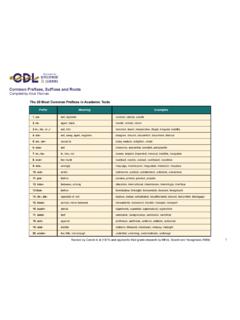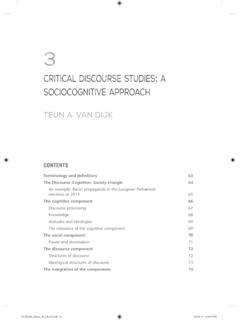Transcription of XENO UNHCR / ames Oatway PH OBIA
1 XENO PH OBIAPROTECTION FROM XENOPHOBIAAn Evaluation of UNHCR s Regional Office for Southern Africa s Xenophobia Related ProgrammesWritten by: Jean Pierre Misago, Iriann Freemantle & Loren B. LandauThe African Centre for Migration and Society, University of Witwatersrand UNHCR / James Oatway1 Written by: Jean Pierre Misago, Iriann Freemantle & Loren B. LandauThe African Centre for Migration and Society University of Witwatersrand UNHCR , February 2015 PROTECTION FROM XENOPHOBIAAn Evaluation of UNHCR s Regional Office for Southern Africa s Xenophobia Related ProgrammesACKNOWLEDGEMENTS This evaluation reviews the attempts of a UNHCR office to protect refugees and asylum-seekers from violent and recurring xenophobic attacks in a country that has a long history of othering within its society.
2 It does more than just measure the impact and efficacy of four programmes implemented to mitigate xenophobia in South Africa. It explores reasons why traditional awareness raising programmes have not worked. It is also a clarion call to UNHCR to globally reconsider its approach to xenophobia which has emerged as a well-documented deterrent to refugees and asylum seekers being able to make a living and coexist peacefully in their cities and towns of exile. If refugees have to live in constant and real fear of persecution in their places of refuge, what protection has actually been provided? As the evaluation reports, xenophobia has social, political and economic roots that are closely intertwined. Yet no matter how complex, every story has a starting point.
3 This evaluation does too. The beginning is worth acknowledging and appreciating. It was initiated at the behest of the Regional Representative not only to measure the efficacy of ongoing xenophobia related programmes in the UNHCR Regional Office for South Africa ( UNHCR ROSA) but also to receive clear recommendations that are based on best practices in xenophobia related programming. The curiosity and courage to start this process of research and evaluation is thankfully recognised. The UNHCR ROSA staff and their South African partners who implemented the programmes are also gratefully acknowledged. Amongst them are Alphonse Munyaneza and Tina Ghelli from UNHCR ROSA and the staff from the Xaveri Movement in Mamelodi, the Agency for Refugee Education, Skills Training & Advocacy (ARESTA), Thetha FM Radio Station and the Displaced and Migrant Persons Support Programme (DMPSP).
4 They are professionals who found themselves in a difficult and disturbing situation without a clear map or resources to change it. To date, there are not many guidelines and good practice documents to steer xenophobia related programming. In this vacuum, these dedicated humanitarians were creative and bold and explored new, interesting partnerships. Some were more effective than others. The authors of this report, Jean-Pierre Misago, Loren Landau and Iriann Freemantle, and their research teams also deserve credit for gathering the data to try to measure the effectiveness of these programmes. Of the good, effective examples in this report, one of these alliances is particularly notable and stands as a best practice because it draws upon proven leaders in the community; it relies on existing structures and, in doing so, provides a more sustainable solution.
5 In the period this evaluation covers, UNHCR ROSA established a relationship with the South African Police Service (SAPS) in responding to xenophobic attacks. This was possible because of the commitment to justice and dedication to peaceful coexistence of General Chippu of SAPS. General Chippu led his team, notably including Captain Modika, to respond at all hours to violent incidents targeting refugees on countless occasions. Their contribution to the overall efforts to protect refugees and asylum-seekers is worthy of particular Morand Senior Policy & Evaluation Officer Policy Development & Evaluation Service UNHCR5 TABLE CONTENTSACRONYMS ..9 EXECUTIVE SUMMARY ..10 KEY FINDINGS AND CONCLUSIONS ..10 PRIMARY RECOMMENDATIONS ..121 INTRODUCTION .. EVALUATION OBJECTIVES AND QUESTIONS.
6 PROGRAMMES SELECTED FOR EVALUATION .. PRIMARY FINDINGS AND CONCLUSIONS .. STRUCTURE OF THE REPORT ..152 OPERATIONAL CONTEXT: XENOPHOBIA IN SOUTH AFRICA SCOPE, NATURE AND RESPONSES .. INTRODUCTION .. Overview .. Conceptual understandings of xenophobia .. Xenophobia: A phenomenon of global dimensions .. XENOPHOBIA IN SOUTH AFRICA: SCOPE, NATURE AND RESPONSES .. Scope .. xenophobic manifestations in South Africa .. Considering explanations for violence: Causes and triggers .. Responding to xenophobia in South Africa ..253 EVALUATION METHODOLOGY .. GENERAL METHODOLOGICAL APPROACH: PROCESS AND IMPACT EVALUATION .. RESEARCH DESIGN .. Qualitative approach .. Sources of data and information .. Sampling .. Data collection and analysis .. Limitations ..3464 FINDINGS.
7 ADDRESSING XENOPHOBIA IN SOUTH AFRICA: STRATEGIC APPROACH, MANDATE AND PARTNERSHIPS .. UNHCR ROSA s strategic approach to addressing xenophobia in South Africa .. Xenophobia and the protection mandate .. Partnerships and collaborations .. CASE STUDIES: FINDINGS FROM SELECTED PROGRAMMES .. Peace education among refugee and local community youth through sport activities (by Xaveri Movement) .. Ubuntu has no borders community radio programme (by Thetha FM radio) .. Self-reliance activities for urban refugees and asylum-seekers in western cape (by the Agency for Refugee Education, Skills, Training & Advocacy: ARESTA) .. Promotion of social cohesion among refugees, asylum-seekers and nationals (by Militia Trust/Displaced and Migrant Persons Support Programme: DMPSP).
8 Case studies conclusion ..755 CONCLUSIONS: GENERAL SUMMARY AND DISCUSSION OF FINDINGS ..776 RECOMMENDATIONS ..79 REFERENCES ..83 APPENDICES ..86 APPENDIX I: List of key informants interviews by organization and by research site ..86 APPENDIX II: Interview guides ..87 APPENDIX III: Chain of evidence supporting recommendations ..91 APPENDIX IV: UNHCR Guidance Document: Combating racism, racial discrimination, xenophobia and related intolerance through a strategic approach (December 2009)..94 APPENDIX V: A critical review of UNHCR 's guidance on combating racism, racial discrimination, xenophobia and related intolerance through a strategic approach ..1047 UNHCR / Helene Caux8 ACRONYMS ACMS African Centre for Migration & Society ANC African National Congress ARESTA The Agency for Refugee Education.
9 Skills Training & Advocacy CoRMSA The Consortium for Refugees and Migrants in South Africa COSATU The Congress of South African Trade Unions CPF Community Policing Forum CRAI Citizenship Rights in Africa Initiative DAC Department of Arts and Culture DHA Department of Home Affairs DMPSP Displaced and Migrant Persons Support Programme DoJ Department of Justice DRC Democratic Republic of Congo FBO Faith-Based Organization FIFA F d ration Internationale de Football Association GCRO Gauteng City-Region Observatory GGBF Greater Gauteng Business Forum HSRC Human Sciences Research Council IDASA Institute for a Democratic Alternative for South Africa ILO International Labour Organization IOM International Organization for Migration IP ( UNHCR s) Implementing Partner LHR Lawyers for Human Rights MP Member of Parliament NGO Non-Governmental Organization OCHA UN Office for the Coordination of Humanitarian Affairs PDES ( UNHCR s) Policy Development and Evaluation Service PoC ( UNHCR s)
10 Persons of Concern PWG Protection Working Group RBX Roll Back Xenophobia RSA Republic of South Africa SABA South African Blacks Association SAHRC South African Human Rights Commission SAPS South African Police Service To R Terms of Reference UN United Nations UNHCR United Nations High Commissioner for Refugees UNHCR ROSA UNHCR Regional Office of Southern Africa US United Sates9 Xenophobia threatens the lives and livelihoods of refugees, asylum seekers, economic migrants and other locally defined outsiders including domestic migrants and ethnic minorities. Recognising the risks xenophobia poses to its persons of concern (PoC), the United Nations High Commissioner for Refugees Regional Office for Southern Africa ( UNHCR ROSA) has initiated a range of activities aimed to protect PoC from its manifestations.















